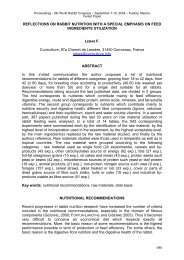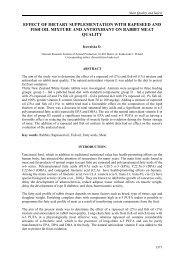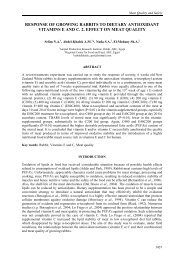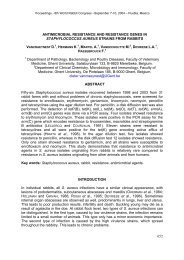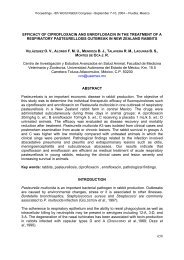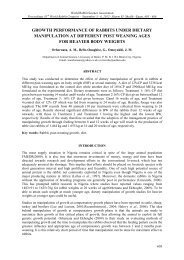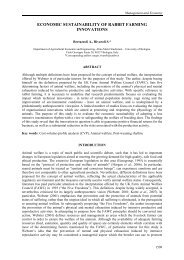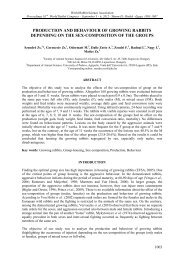commercialization of rabbit's meat in tizi-ouzou area, algeria
commercialization of rabbit's meat in tizi-ouzou area, algeria
commercialization of rabbit's meat in tizi-ouzou area, algeria
You also want an ePaper? Increase the reach of your titles
YUMPU automatically turns print PDFs into web optimized ePapers that Google loves.
Management and Economy<br />
COMMERCIALIZATION OF RABBIT’S MEAT IN TIZI-OUZOU<br />
AREA, ALGERIA<br />
Kadi S.A. 1,3 *, Djellal F. 2 , Berchiche M. 3<br />
1 Centre de Formation Pr<strong>of</strong>essionnelle et de l’Apprentissage, Mechtras, 15440 Tizi-Ouzou, Algeria<br />
2 I.T.Elv, BP.03, Route de Chebli, Birtouta, Alger, Algeria<br />
3 Département des sciences agronomiques, Université Mouloud Mammeri, Tizi-Ouzou. Algeria<br />
*Correspond<strong>in</strong>g author: kadisiammar@yahoo.fr<br />
ABSTRACT<br />
This paper provides an overview <strong>of</strong> the rabbit <strong>meat</strong> market<strong>in</strong>g system <strong>in</strong> the Tizi-Ouzou <strong>area</strong>. To meet<br />
this objective the descriptive survey method was employed, us<strong>in</strong>g a structured questionnaire to provide<br />
data on <strong>commercialization</strong> <strong>of</strong> rabbit <strong>meat</strong>. Butcheries (n=192 represent<strong>in</strong>g 67.3% <strong>of</strong> the total<br />
butcheries), poulterers (n=49 represent<strong>in</strong>g 30.6% <strong>of</strong> the total poulterers), restaurants (n=184<br />
represent<strong>in</strong>g 43.4% <strong>of</strong> the total ones) and hotels (n=11 represent<strong>in</strong>g 25.5% <strong>of</strong> the total ones) were<br />
concerned. Rabbit <strong>meat</strong> is sold <strong>in</strong> 8.48% (n=37) <strong>of</strong> stores visited and do not sold <strong>in</strong> 91.51% (n=399)<br />
ones. It’s marketed more cooked (restaurants and hotels) than fresh (butcheries and poulterers).<br />
75.44% <strong>of</strong> respondents who do not sell rabbit <strong>meat</strong> justifies it by the lack <strong>of</strong> demand and 10.78%<br />
(n=43) because <strong>of</strong> its unavailability. Rabbits are bought from producers generally as whole carcasses<br />
(86.49%) <strong>of</strong> about 1.4 kg for an average price <strong>of</strong> 312.16 DA per kg (1U$=85 DA).In the butcheries<br />
and poulterers, rabbit <strong>meat</strong> is sold to consumers at an average price <strong>of</strong> 470 DA. 44.56 kg <strong>of</strong> rabbit<br />
<strong>meat</strong> are sold per week. Although the local demand cont<strong>in</strong>ues to <strong>in</strong>crease, the market<strong>in</strong>g for rabbit<br />
<strong>meat</strong> <strong>in</strong> Tizi-Ouzou stays neglected. The market<strong>in</strong>g is fragmented, <strong>in</strong>efficient so the distribution cha<strong>in</strong><br />
<strong>of</strong> this <strong>meat</strong> is disorganized. This <strong>in</strong>efficient market<strong>in</strong>g system has resulted <strong>in</strong> higher costs and low<br />
availability <strong>of</strong> rabbit <strong>meat</strong> with a possibility for expansion through appropriate promotion. Despite<br />
those problems, there are also opportunities for expansion <strong>of</strong> this market. Given the current low levels<br />
<strong>of</strong> consumption <strong>of</strong> rabbit <strong>meat</strong>, there is a potential for total consumption <strong>of</strong> this <strong>meat</strong> to <strong>in</strong>crease<br />
substantially as production and availability <strong>in</strong>creases. The ultimate objective is to educate the public<br />
about the high nutritional quality <strong>of</strong> rabbit <strong>meat</strong>. More attention must be given to the market outlets<br />
and promotions <strong>of</strong> rabbit <strong>meat</strong> <strong>in</strong> Tizi-Ouzou <strong>area</strong>.<br />
Key words: Rabbit <strong>meat</strong>, Market<strong>in</strong>g, Tizi-Ouzou.<br />
INTRODUCTION<br />
Rabbit production <strong>in</strong> Algeria actively participate <strong>in</strong> the reduction <strong>of</strong> the animal prote<strong>in</strong> shortage <strong>of</strong> the<br />
population (Gacem and Lebas, 2000).While efforts have been taken to promote rabbit production <strong>in</strong><br />
rational level. In Algeria, rabbit production is concentrated ma<strong>in</strong>ly <strong>in</strong> the east and center <strong>of</strong> the country<br />
and Tizi-Ouzou is the highest production region <strong>of</strong> rabbit <strong>meat</strong>. Those last years, a pilot project has<br />
been carried out <strong>in</strong> Tizi-Ouzou: Formation <strong>of</strong> the new (young) breeders before the creation <strong>of</strong> the<br />
rabbit unit, creation <strong>of</strong> the rais<strong>in</strong>g facilities with local materials and distribution <strong>of</strong> 16 does + 2 males<br />
for each unit. In spite <strong>of</strong> the encountered problems, part <strong>of</strong> these units cont<strong>in</strong>ue to work and to produce<br />
rabbit (Zerrouki et al., 2005b). Meat market <strong>in</strong> Algeria is very complex and the literature on its<br />
operation is limited. The publications which relates to rabbit market<strong>in</strong>g is non-existent. To date, much<br />
<strong>of</strong> the research on rabbits carried out <strong>in</strong> Tizi-Ouzou University has centered on production practices.<br />
No market assessment studies are undertaken. In assess<strong>in</strong>g the market for an <strong>in</strong>frequently consumed<br />
commodity, such as rabbit <strong>meat</strong>, the actions <strong>of</strong> both users and nonusers must be evaluated. The aim <strong>of</strong><br />
this paper is to <strong>in</strong>vestigate rabbit <strong>meat</strong> market<strong>in</strong>g <strong>in</strong> the wilaya (district) <strong>of</strong> Tizi-Ozou.<br />
1559
9 th World Rabbit Congress – June 10-13, 2008 – Verona – Italy<br />
MATERIALS AND METHODS<br />
The aim <strong>of</strong> this survey was to <strong>in</strong>vestigate rabbit <strong>meat</strong> market<strong>in</strong>g <strong>in</strong> the wilaya <strong>of</strong> Tizi-Ozou (a wilaya =<br />
a geopolitical district). To meet this objective the descriptive survey method was employed, us<strong>in</strong>g a<br />
structured questionnaire to provide data on <strong>commercialization</strong> <strong>of</strong> rabbit <strong>meat</strong>. The questionnaires<br />
aimed the butcheries (n=192 represent<strong>in</strong>g 67.3% <strong>of</strong> the total <strong>of</strong> butcheries), poulterers (n=49<br />
represent<strong>in</strong>g 30.6% <strong>of</strong> the total poulterers), restaurants (n=184 represent<strong>in</strong>g 43.4% <strong>of</strong> the total ones)<br />
and hotels (n=11 represent<strong>in</strong>g 25.5% <strong>of</strong> the total ones). The questions were about the presence ma<strong>in</strong>ly<br />
or not <strong>of</strong> this <strong>meat</strong> and <strong>in</strong> particular on the frequency <strong>of</strong> the demand by the clientele, the sources and<br />
places <strong>of</strong> provision<strong>in</strong>g, weight and price <strong>of</strong> the carcasses, pr<strong>of</strong>ile <strong>of</strong> the consumers, quantities used<br />
dur<strong>in</strong>g the week. The data obta<strong>in</strong>ed from the questionnaires were organised by cod<strong>in</strong>g the open-ended<br />
questions, <strong>in</strong> order to prepare them for data captur<strong>in</strong>g.<br />
Data analysis<br />
All data were entered <strong>in</strong>to a Micros<strong>of</strong>t Excel spreadsheet with, <strong>in</strong> l<strong>in</strong>es, the different questionnaires<br />
and, <strong>in</strong> columns, the explanatory and expla<strong>in</strong>ed variables represented by the different questions. The<br />
quantitative data were subjected to the 6,4 version <strong>of</strong> the STATBOX package for determ<strong>in</strong><strong>in</strong>g<br />
descriptive statistics (means, standard deviations, frequencies and percentages). The statistical<br />
significance level <strong>of</strong> differences between the dependent and <strong>in</strong>dependent variables were determ<strong>in</strong>ed by<br />
Chi-square tests at P
Management and Economy<br />
people hav<strong>in</strong>g negative attitude to rabbit <strong>meat</strong> or refuse consumption <strong>in</strong> due to emotional reasons is<br />
weak (Kadi, 2007). In addition, there are no religious apprehensions s<strong>in</strong>ce Islam (pr<strong>in</strong>cipal religion <strong>in</strong><br />
the <strong>area</strong>) does not prohibit the consumption <strong>of</strong> the rabbit <strong>meat</strong>.<br />
Table 2: Reasons for which the rabbit <strong>meat</strong> is not sold<br />
Number <strong>of</strong> respondents Proportion (%)<br />
Not asked for by the customers 301 75.44<br />
Traditions 20 5.01<br />
Expensive 18 4.51<br />
Unavailable 43 10.78<br />
It resembles to the cat 2 0.50<br />
Without idea 15 3.76<br />
Format <strong>of</strong> rabbit <strong>meat</strong> and source <strong>of</strong> provision<strong>in</strong>g<br />
Rabbits are marketed live or killed to Butcheries, Poulterers and restaurants (Table 3). They are<br />
bought from producers generally as whole carcasses (86.49%) <strong>of</strong> about 1.4±0.5 kg for an average price<br />
<strong>of</strong> 312.16±49 DA (1$= 85 DA). Whole carcasses <strong>in</strong>cludes head, thoracic content (heart, lungs, …),<br />
liver, kidneys and extremities <strong>of</strong> the legs and the correspond<strong>in</strong>g sk<strong>in</strong>. The <strong>of</strong>fal are thrown. The weight<br />
<strong>of</strong> carcasses (1.4±0.5 kg) seems <strong>in</strong>terest<strong>in</strong>g compared to the modest growth performances <strong>of</strong> this<br />
population (Kadi and Berchiche, 2002). For <strong>in</strong>dication, on the level <strong>of</strong> French market, the average<br />
carcass weighs 1.4 kg (Lebas, 2003)<br />
Table 3: State <strong>of</strong> rabbits to the purchase<br />
Number <strong>of</strong> respondents Proportion (%)<br />
Alive 5 13.51<br />
Slaughtered 32 86.49<br />
There is no slaughter-house specialized <strong>in</strong> the slaughter<strong>in</strong>g <strong>of</strong> rabbits <strong>in</strong> the <strong>area</strong> <strong>of</strong> study. The rabbits<br />
are slaughtered by cutt<strong>in</strong>g the jugular ve<strong>in</strong> with a sharp knife and stripped <strong>in</strong>to the rabbiteries. Present<br />
country laws do not require veter<strong>in</strong>ary <strong>in</strong>spection <strong>of</strong> rabbit process<strong>in</strong>g or <strong>of</strong> rabbit <strong>meat</strong> before it can<br />
be sold <strong>in</strong> retail outlets. So, the rabbit producer is responsible for ensur<strong>in</strong>g that the rabbit <strong>meat</strong> sold is<br />
wholesome and properly handled prior to delivery. As well as the butchers and Poulterers, the<br />
restorers and hotels are <strong>in</strong> majority (78.38%) supplied on rabbit’s <strong>meat</strong> directly by the producers<br />
(Table 4). Only 8.11% <strong>of</strong> the respondents buy their merchandise outside <strong>of</strong> the wilaya.<br />
Table 4: Source <strong>of</strong> provision<strong>in</strong>g <strong>of</strong> the restorers and hotels<br />
Source <strong>of</strong> provision<strong>in</strong>g (n.) Proportion (%)<br />
Breeders 29 78.38<br />
Butcheries 4 10,81<br />
Weekly Market 2 5.41<br />
Other 2 5.41<br />
Price and availability <strong>of</strong> rabbit <strong>meat</strong><br />
In the Butcheries and Poulterers, the average market value <strong>of</strong> this rabbit <strong>meat</strong> is 470 ± 62 DA per kg.<br />
In the wilaya <strong>of</strong> Constant<strong>in</strong>e and Algiers, the prices seems more acceptable: 360 to 380 DA per kg<br />
(Gacem and Lebas, 2000). Chicken usually costs less than DA 250 per kg. This is not exclusive to<br />
Algeria. Dalle Zotte (2002) argues that <strong>in</strong> developed countries the production costs for rabbits are<br />
twice as high as for chicken broilers. This implies that rabbit <strong>meat</strong> consequently becomes more<br />
expensive than other white <strong>meat</strong>s and thus its consumption is automatically decreased especially at<br />
level <strong>of</strong> low-<strong>in</strong>come families which are the most numerous <strong>in</strong> the Tizi-Ouzou <strong>area</strong>.<br />
However, the most frequent problem is the lack <strong>of</strong> rabbit <strong>meat</strong> <strong>in</strong> the Butcheries and Poulterers, so<br />
urban citizens, lik<strong>in</strong>g rabbit <strong>meat</strong> can buy it only <strong>in</strong> few stores at the level <strong>of</strong> the urban center <strong>of</strong> the<br />
city <strong>of</strong> Tizi-<strong>ouzou</strong>, <strong>of</strong>ten far from several kilometers <strong>of</strong> the dwell<strong>in</strong>g place. The ma<strong>in</strong> problem <strong>in</strong><br />
rational rais<strong>in</strong>g <strong>of</strong> rabbits <strong>in</strong> Algeria is that commercial feeds are more expensive. This is, <strong>in</strong> part,<br />
1561
9 th World Rabbit Congress – June 10-13, 2008 – Verona – Italy<br />
because many <strong>of</strong> their ma<strong>in</strong> <strong>in</strong>gredients as soybean meal, dehydrated alfalfa, corn and other micro<strong>in</strong>gredients,<br />
are imported from overseas. Dehydrated alfalfa and soybean meal <strong>of</strong>ten comprise 30 to<br />
40% and 10 to 20%, respectively <strong>of</strong> the feed ration for rabbits.<br />
In addition to higher cost <strong>of</strong> production, due to the lack <strong>of</strong> access to important <strong>in</strong>puts and services,<br />
smallholders tend to have lower productivity. Accord<strong>in</strong>g to Zerrouki et al. (2005b), the numerical<br />
productivity recorded <strong>in</strong> this region is about 25 to 30 rabbits weaned/female/year. For the same<br />
population and <strong>in</strong> the experimental farm, Zerrouki et al. (2005a) got slightly better performances but<br />
confirms (Daoud-Zerrouki, 2006) the limits <strong>of</strong> this genotype.<br />
Lack <strong>of</strong> technical know-how is the other reason which decreases the productivity. Many rabbits raisers<br />
do not control the techniques <strong>of</strong> rais<strong>in</strong>g especially the reproduction. The majority <strong>of</strong> breeders have<br />
limited education, which limits their capacity to adopt new methods.<br />
Relation between type <strong>of</strong> store and <strong>in</strong>dependent variables<br />
Source <strong>of</strong> approvisionn<strong>in</strong>g, education level <strong>of</strong> customers and quantities <strong>of</strong> rabbit <strong>meat</strong> sold per week<br />
are not related to the type <strong>of</strong> store (Table 5). Whereas, was observed the difference (P
Management and Economy<br />
ACKNOWLEDGEMENTS<br />
The authors want to thank greatly Kourat O. for technical assistance.<br />
REFERENCES<br />
Berchiche M., Kadi S.A. 2002. The kabyle rabbits (Algeria). In: Rabbit Genetic Resources <strong>in</strong> Mediterranean Contries. (Edit.<br />
Khalil M.H., Baselga M.) Options méditerranéennes, Serie B, Etudes et recherches, N° 38, pp 15-20.<br />
Dalle Zotte A D. 2002. Perception <strong>of</strong> rabbit <strong>meat</strong> quality and major factors <strong>in</strong>fluenc<strong>in</strong>g the rabbit carcass and <strong>meat</strong> quality.<br />
Livestock Production Science, 75(1), 11-32.<br />
Daoud-Zerrouki N. 2006. Caractérisation d'une population locale de lap<strong>in</strong>s en Algérie: Evaluation des performances de<br />
reproduction des lap<strong>in</strong>es en élevage rationnel. Thèse de Doctorat en Biologie (option Biologie animale), Université<br />
Mouloud Mammeri de Tizi-Ouzou, 2006 June, 131 pp.<br />
Djellal F., Mouhous A., Kadi S.A. 2006. Performances de l'élevage fermier du lap<strong>in</strong> dans la région de Tizi-Ouzou, Algérie.<br />
Livestock Research for Rural Development, 18, Article # 100. http://www.cipav.org.co/lrrd/lrrd18/07/djel18100.htm.<br />
Gacem M., Lebas F. 2000. Rabbit husbandry <strong>in</strong> Algeria. Technical structure and evaluation <strong>of</strong> performances. In: Proc. 7 th<br />
World Rabbit Congress, 2002 July, Valencia, Spa<strong>in</strong>.<br />
Lebas F. 2003. La production française de lap<strong>in</strong> en 2002 et tendances pour 2003. Cuniculture Magaz<strong>in</strong>e,30, 20-29.<br />
Teafa G.G. 1990. Techniques for promot<strong>in</strong>g and market<strong>in</strong>g rabbit <strong>meat</strong>. J. Appl.. Rabbit Res., 13, 20-23.<br />
Zerrouki N., Bolet G., Berchiche M., Lebas F. 2005a. Evaluation <strong>of</strong> breed<strong>in</strong>g performance <strong>of</strong> a local Algerian rabbit<br />
population raised <strong>in</strong> the Tizi-Ouzou <strong>area</strong> (kabylia). World Rabbit Sci., 13, 29–37.<br />
Zerrouki N., Kadi S.A., Berchiche M., Bolet G. 2005b. Evaluation de la productivité des lap<strong>in</strong>es d’une population locale<br />
algérienne, en station expérimentale et dans des élevages. In: Proc. 11 èmes Journées de la Recherche Cunicole, 2005<br />
November, Paris, France, 11-14.<br />
1563
9 th World Rabbit Congress – June 10-13, 2008 – Verona – Italy<br />
1564





